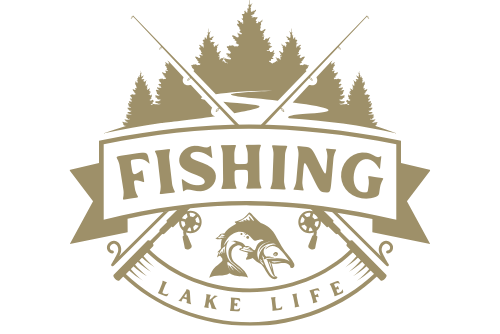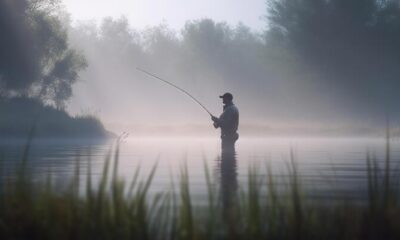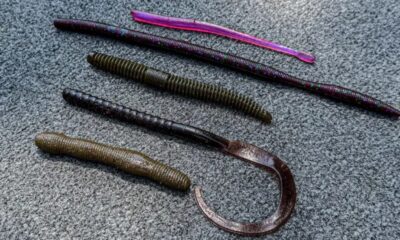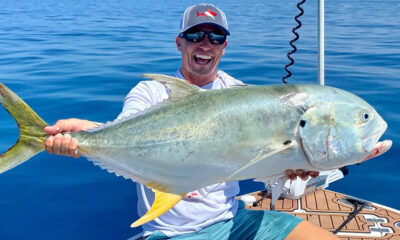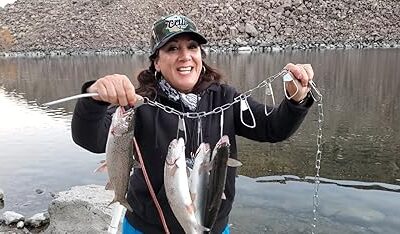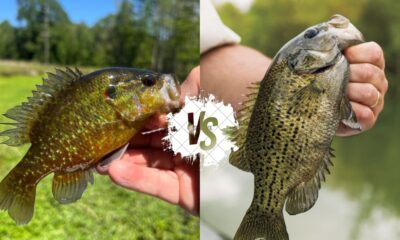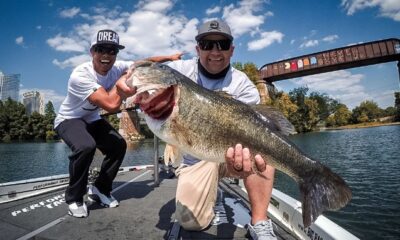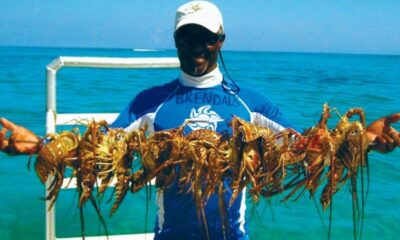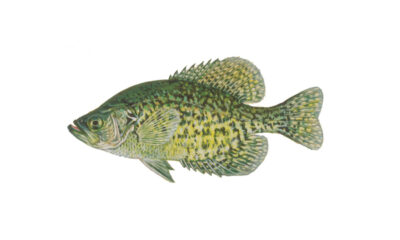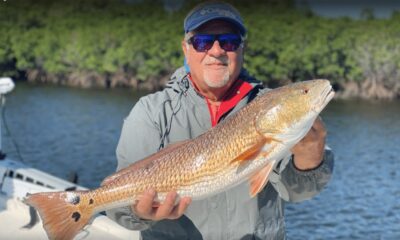Fishing Guides
Top 6 Pros and Cons of Eating Black Drum Fish
Introduction
Seafood is a staple in many diets around the world, and one fish that has gained popularity in recent years is the black drum. This unique species, found predominantly along the Atlantic and Gulf coasts of the United States, offers a distinct flavor and texture that has caught the attention of seafood enthusiasts and health-conscious consumers alike. However, like any food choice, there are both pros and cons to consider when it comes to eating black drum fish.
In this comprehensive guide, we’ll delve into the potential benefits and drawbacks of incorporating black drum into your diet, exploring its nutritional value, sustainability, and potential health concerns. By understanding both sides of the equation, you’ll be better equipped to make an informed decision about whether this versatile fish should have a place on your plate.
You may also like to read “ Top 10 Facts About Drum Fish” article.
What is Black Drum Fish?
Before we dive into the pros and cons of black drum fish, let’s first understand what black drum fish is and where it comes from.
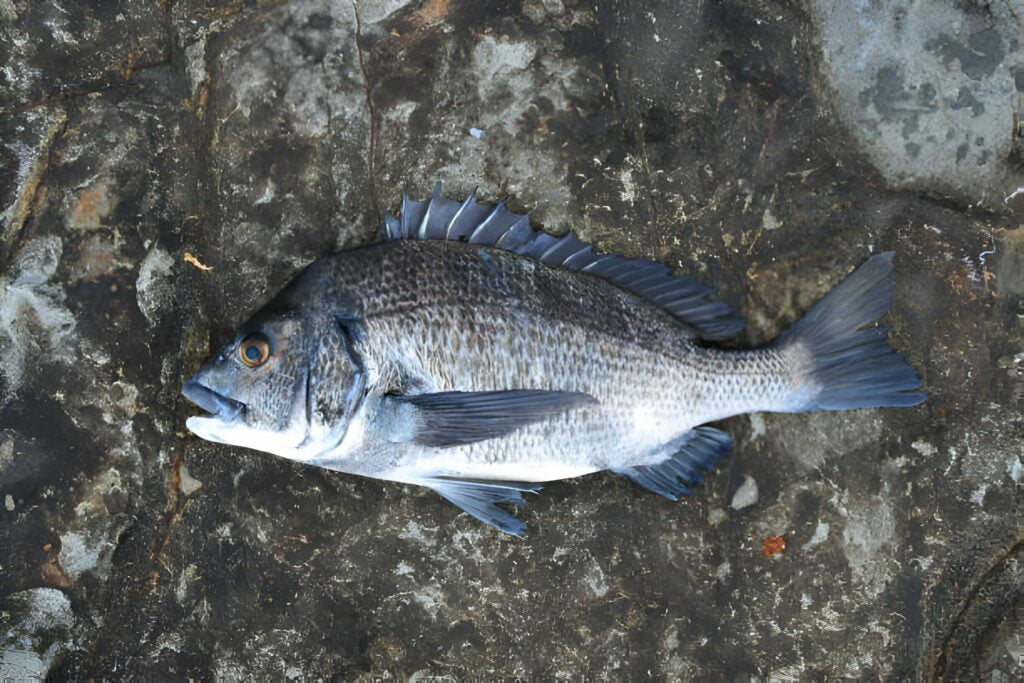
Black Drum Fish
Definition and Biology
The black drum (Pogonias cromis) is a marine fish species that belongs to the Sciaenidae family, commonly known as croakers or drums. These fish are characterized by their distinctive lateral line, which extends onto their large, rounded tail, and their ability to produce a drumming sound by vibrating their swim bladder.
Black drum can grow to impressive sizes, with some individuals reaching lengths of over 4 feet and weights exceeding 100 pounds. They are found primarily in coastal waters along the Atlantic and Gulf coasts of the United States, ranging from Massachusetts to Mexico.
Habitat and Fishing Methods
Black drum fish inhabit a variety of coastal environments, including bays, estuaries, and nearshore waters. They are bottom-dwellers, feeding on mollusks, crustaceans, and small fish found on or near the seafloor.
These fish are typically caught using a variety of methods, including rod and reel, handlines, and commercial fishing techniques like gill nets and trawls. Recreational anglers often target black drum from piers, beaches, and boats, as they put up a powerful fight when hooked.
Pros of Eating Black Drum Fish
Nutritional Benefits
One of the primary advantages of consuming black drum fish is its impressive nutritional profile. This fish is an excellent source of high-quality protein, essential for building and repairing tissues in the body. Additionally, black drum is rich in various vitamins and minerals, including:
- Omega-3 Fatty Acids: Black drum is a good source of omega-3 fatty acids, particularly EPA and DHA, which have been linked to numerous health benefits, such as improved cardiovascular health and brain function.
- Vitamin B12: This essential vitamin plays a crucial role in red blood cell formation, neurological function, and DNA synthesis.
- Selenium: A powerful antioxidant that supports immune function and may help protect against certain types of cancer.
- Phosphorus: An essential mineral for healthy bones and teeth, as well as proper cell function.
Sustainability and Environmental Impact
Another advantage of choosing black drum as a seafood option is its relatively sustainable nature. According to the National Oceanic and Atmospheric Administration (NOAA), black drum populations in both the Atlantic and Gulf of Mexico are not overfished, and current fishing levels are sustainable.
Additionally, the fishing methods used to catch black drum, such as hook-and-line and gill nets, have a lower environmental impact compared to more destructive practices like bottom trawling.
Versatility in Cooking
Black drum is a versatile fish that lends itself well to various cooking methods and flavor profiles. Its firm, white flesh holds up well to grilling, baking, frying, and even smoking, making it a popular choice for a wide range of dishes.
Whether you prefer a simple preparation with lemon and herbs or a more complex flavor profile with spices and sauces, black drum’s unique taste and texture can accommodate a variety of culinary styles.
Cons of Eating Black Drum Fish
Potential Mercury Contamination
While black drum offers numerous nutritional benefits, there are also potential drawbacks to consider. One concern is the potential for mercury contamination, particularly in larger, older individuals.
Mercury is a naturally occurring element that can accumulate in fish tissues, and larger, longer-lived predatory fish tend to have higher levels. While black drum is not considered a top predator, it can still accumulate mercury from its diet of mollusks and small fish.
Consuming fish with high levels of mercury can be harmful, particularly for pregnant women, nursing mothers, and young children, as mercury can adversely affect the developing nervous system.
Worms and Parasites
Another potential issue with consuming black drum is the risk of encountering worms or parasites. Like many fish species, black drum can harbor various types of parasitic worms or other organisms, which can be unpleasant or even harmful if consumed.
Proper handling, cleaning, and cooking techniques can help mitigate this risk, but it’s essential to be aware of the potential for parasites and to inspect the fish thoroughly before consumption.
Sustainability Concerns in Some Areas
While black drum populations are generally considered sustainable on a broad scale, there may be localized areas or specific fisheries where overfishing or other environmental factors have led to population declines.
It’s essential to be aware of the local conditions and regulations surrounding black drum fishing in your area, as well as to support sustainable and responsible fishing practices to ensure the long-term viability of this species.
Comparison: Black Drum vs. Other Popular Fish
To better understand the pros and cons of eating black drum, it can be helpful to compare it to other popular fish species. Here’s a brief comparison of black drum to two commonly consumed fish:
| Criteria | Black Drum | Salmon | Tilapia |
|---|---|---|---|
| Omega-3 Content | Good source | Excellent source | Low source |
| Mercury Levels | Moderate risk | Low risk | Low risk |
| Sustainability | Generally sustainable | Varies by species and region | Often farmed, sustainability concerns |
| Flavor and Texture | Firm, mild flavor | Rich, fatty flavor | Mild, versatile flavor |
As you can see, black drum offers a good balance of nutritional benefits and sustainability, while also presenting some potential drawbacks in terms of mercury and parasites that should be considered.
Tips for Safe and Sustainable Black Drum Consumption
If you decide to incorporate black drum into your diet, here are some tips to ensure safe and sustainable consumption:
Choose Smaller, Younger Fish
To minimize the potential for mercury contamination, opt for smaller, younger black drum when possible. These younger fish have had less time to accumulate high levels of mercury in their tissues.
Proper Handling and Cooking
Proper handling and cooking techniques are essential for reducing the risk of foodborne illnesses from black drum or any other fish. Follow recommended guidelines for cleaning, storing, and thoroughly cooking the fish to kill any potential parasites or bacteria.
Support Sustainable Fisheries
When purchasing black drum or any other seafood, look for products that are certified as sustainable by organizations like the Marine Stewardship Council (MSC) or the Aquaculture Stewardship Council (ASC). These certifications help ensure that the fish you’re consuming comes from well-managed and environmentally responsible fisheries or aquaculture operations.
Eat in Moderation
As with any food, moderation is key. While black drum can be a nutritious addition to your diet, it’s essential to consume it in appropriate portions and as part of a balanced, varied diet.
Conclusion
Eating black drum fish can offer both advantages and potential drawbacks. On the plus side, this unique species is a good source of high-quality protein, omega-3 fatty acids, and various essential vitamins and minerals. Additionally, black drum populations are generally considered sustainable, and the fishing methods used to catch them have a relatively low environmental impact.
However, there are also concerns to consider, such as the potential for mercury contamination, particularly in larger, older individuals, and the risk of encountering worms or parasites. It’s essential to weigh these pros and cons carefully and to follow safe handling and cooking practices to minimize any potential risks.
Ultimately, whether or not to include black drum in your diet is a personal decision that should be based on your individual preferences, health considerations, and environmental values. By understanding the unique characteristics of this fish and making informed choices, you can enjoy the benefits of black drum while minimizing any potential drawbacks.
Fishing Guides
Warmouth vs Rock Bass – Which Species Reigns Supreme?
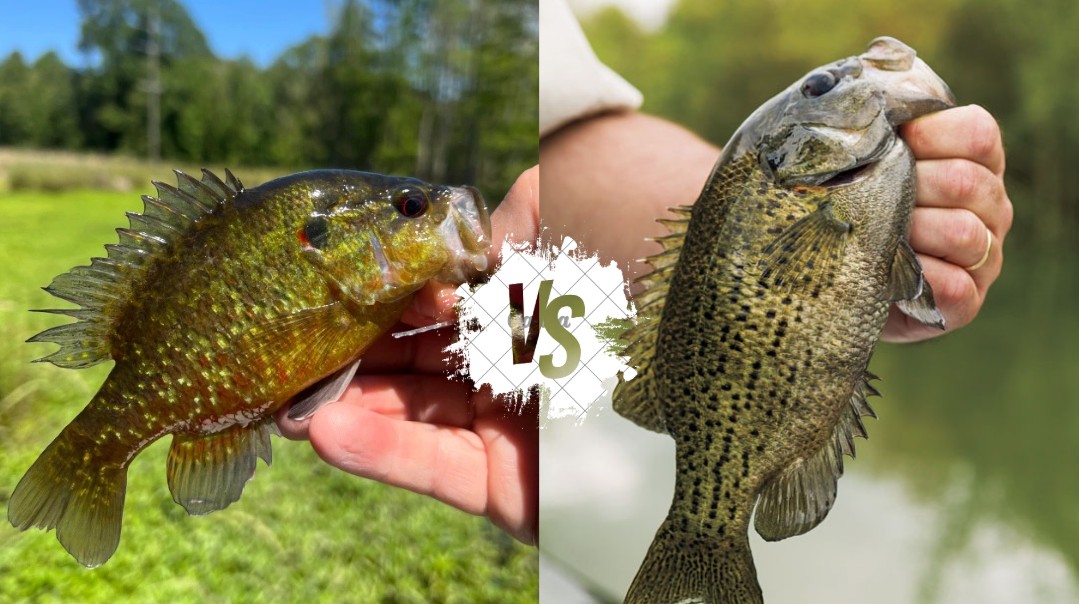
The warmouth and rock bass are two feisty panfish that ignite passion among anglers, sparking debates over which species offers the better fishing experience. Both belong to the sunfish family, sharing traits like spiny fins and a love for cover, but their unique characteristics—appearance, behavior, habitat, and angling appeal—set them apart. Whether you’re casting in a murky southern pond or a clear northern stream, deciding whether warmouth or rock bass reigns supreme depends on your fishing goals. This comprehensive guide compares these species across multiple dimensions, providing practical insights and real-world examples to help anglers choose their champion.
You may also like to read “ Lifespan of a largemouth bass” article.
Introducing Warmouth and Rock Bass
Warmouth (Lepomis gulosus) and rock bass (Ambloplites rupestris) are beloved for their accessibility, aggressive bites, and spirited fights, making them ideal targets for beginners and seasoned anglers alike. The warmouth, often nicknamed “goggle-eye” for its large eyes, thrives in warm, sluggish waters and is known for its voracious appetite. The rock bass, or “redeye” due to its striking red eyes, prefers cooler, clearer streams and lakes, delivering a scrappy battle on light tackle. Each species brings something unique to the table, from habitat preferences to angling challenges.
Choosing between them hinges on factors like ease of catching, fight quality, or culinary value. For anglers looking to hone their panfish skills, our guide to panfish fishing techniques offers strategies tailored to species like warmouth and rock bass. By exploring their differences and similarities, we’ll determine which fish deserves the crown in the eyes of anglers.
Warmouth: The Bold Predator
Native to the southeastern United States but widely introduced, warmouth flourish in warm, slow-moving waters such as ponds, swamps, and bayous. They typically grow to 6–10 inches, with some reaching 12 inches and weighing up to a pound. Their olive-to-brown bodies, adorned with mottled, chain-like patterns, blend seamlessly into weedy or muddy environments. Warmouth are aggressive feeders, devouring insects, small fish, and crustaceans, which makes them a reliable target year-round. An angler fishing a Louisiana marsh might hook a warmouth ambushing a minnow in shallow grass, its bold strike showcasing its predatory instincts.
Rock Bass: The Stream Warrior
Rock bass, native to the eastern United States and parts of Canada, favor cooler, clearer waters like rocky streams, rivers, and lakes. They also grow to 6–10 inches, with larger specimens hitting 12 inches and a pound. Their olive-green bodies, marked by dark horizontal stripes and vivid red eyes, make them unmistakable. Feeding on insects, crayfish, and small fish, rock bass often lurk near rocks or logs, darting out to strike. An angler casting in Michigan’s Au Sable River might catch a rock bass hiding near a sunken log, its quick, energetic fight a testament to its stream-bred tenacity.
Appearance and Identification
Accurate identification is essential, as warmouth and rock bass can inhabit overlapping waters, leading to occasional confusion. While both share a sunfish-like shape, their coloration, markings, and physical features provide clear distinctions for observant anglers.
Identifying Warmouth
Warmouth have a stout, slightly elongated body with a large mouth, reflecting their scientific name “gulosus” (gluttonous). Their coloration varies from olive to dark brown, with mottled patterns and faint vertical bars. Key identifiers include their large, red or orange eyes—especially vivid in juveniles—and a unique patch of teeth on their tongue. They have 10–11 dorsal fin spines and often display a reddish gill flap edge. An angler fishing a murky Alabama pond might spot a warmouth’s glowing eyes in the shallows, a telltale sign of its presence.
Identifying Rock Bass
Rock bass sport a more streamlined body, with olive-green to bronze coloration and dark, horizontal stripes that fragment into spots toward the belly. Their hallmark is their bright red eyes, earning the “redeye” nickname. They have 5–7 anal fin spines and a slightly forked tail, setting them apart from warmouth. In the clear waters of Ontario’s St. Lawrence River, an angler might notice a rock bass’s red eyes shining against a gravel bottom, making identification straightforward. The U.S. Fish and Wildlife Service provides detailed fish identification resources for anglers seeking clarity.
Habitat and Distribution
Habitat preferences heavily influence where and how anglers pursue warmouth and rock bass. While both species gravitate toward cover-rich environments, their tolerances for water conditions shape their geographic ranges and fishing strategies.
Warmouth Habitat
Warmouth excel in warm, sluggish, or still waters with dense vegetation, such as ponds, lakes, swamps, and slow rivers. They tolerate low oxygen and turbid conditions, thriving from Florida to Texas and as far north as Missouri. They hide near weeds, stumps, or submerged logs, ambushing prey with precision. An angler fishing Georgia’s Okefenokee Swamp might find warmouth lurking in lily pads, striking a small jig cast near cover. Their adaptability to murky, vegetated waters makes them a staple in southern fisheries.
Rock Bass Habitat
Rock bass prefer cooler, clearer waters, including rocky streams, rivers, and lakes with gravel or boulder-strewn bottoms. They’re common from Quebec to the Mississippi River basin, flourishing in places like the Great Lakes and Appalachian waterways. They seek cover near rocks, logs, or undercut banks, using these as ambush points. An angler casting in Virginia’s Shenandoah River might hook a rock bass near a rocky ledge, where it waits for passing crayfish. Their affinity for clear, rocky waters makes them a northern favorite.
Fishing Techniques for Warmouth and Rock Bass
Catching warmouth and rock bass demands tailored approaches, as their habitats and feeding habits require different tactics. Both species are aggressive, making them accessible with simple gear, but specific techniques can elevate your success.
Catching Warmouth
Warmouth respond well to light tackle, such as ultralight spinning rods with 4–6-pound test line. Small jigs, inline spinners, or live baits like worms, crickets, or minnows are effective, especially when fished near cover. A 1/32-ounce jig tipped with a soft plastic grub, worked slowly through weeds, can trigger a strike. Float fishing with a worm under a bobber shines in shallow waters. An angler fishing a Mississippi oxbow lake might use a cricket under a float, landing an 8-inch warmouth hiding in cattails.
Catching Rock Bass
Rock bass are best targeted with light spinning or fly-fishing gear, using 4–8-pound test line and small lures like spinners, crankbaits, or soft plastics. Live baits, such as minnows or crayfish tails, work wonders near rocky structure. Fly anglers can use small streamers or nymphs to mimic insects or baitfish. An angler fishing Wisconsin’s Wolf River might cast a Rooster Tail spinner near a boulder, hooking a 9-inch rock bass. Fishing at dawn or dusk, when rock bass are most active, increases bites. Retailers like Cabela’s stock lures perfect for rock bass angling.
Fight Quality and Angling Experience
The fight delivered by warmouth and rock bass is a major factor in their appeal, as both offer exciting battles on light tackle. Their distinct fighting styles influence which species anglers might prefer.
Warmouth’s Tenacious Fight
Warmouth are relentless fighters, using their broad bodies to pull hard and dive for cover. They shake their heads or roll, creating a challenge on ultralight gear. A 10-inch warmouth can feel like a larger fish, especially in thick vegetation where it tries to wrap the line. An angler fishing a Florida canal might battle a warmouth that burrows into hydrilla, requiring careful rod work to land. Their bulldog-like aggression makes them a thrilling catch, earning high praise for fight quality.
Rock Bass’s Energetic Battle
Rock bass are known for quick, darting runs and relentless energy, often leaping or spinning during the fight. Their streamlined shape enables rapid bursts, making them a joy on light tackle or fly rods. In fast-moving streams, they leverage currents, adding to the challenge. An angler fishing New York’s Catskill streams might hook a rock bass that zips toward a rock pile, testing their finesse. The rock bass’s acrobatic, lively fight captivates anglers seeking action-packed encounters.
Culinary Value and Table Fare
For anglers who enjoy eating their catch, the culinary qualities of warmouth and rock bass are worth comparing. Both are edible, but differences in flavor and preparation affect their appeal as table fare.
Warmouth on the Plate
Warmouth have firm, white flesh with a mild, slightly sweet flavor, making them a solid choice for panfish meals. Their larger size yields more fillets than smaller sunfish, though bones require careful removal. Pan-frying or baking with simple seasonings brings out their best. An angler in Arkansas might keep a few 9-inch warmouth for a fish fry, enjoying their crispy texture after coating in cornmeal. Proper filleting, as advised by Bassmaster, ensures a bone-free dining experience.
Rock Bass on the Plate
Rock bass offer flaky, white flesh with a mild, slightly earthier taste than warmouth. Their smaller size means less meat, and bones can be tedious to remove. Grilling or pan-frying with herbs enhances their flavor. An angler in Ohio might cook a 10-inch rock bass for a lakeside lunch, savoring its delicate taste after a morning of fishing. While tasty, their limited fillet size makes them less ideal for large meals compared to warmouth.
Warmouth vs. Rock Bass Comparison Table
The table below highlights key differences between warmouth and rock bass, aiding anglers in choosing their preferred target.
| Feature | Warmouth | Rock Bass |
|---|---|---|
| Appearance | Mottled olive-brown, large red/orange eyes | Olive-green, red eyes, dark stripes |
| Habitat | Warm, murky ponds, swamps, slow rivers | Cool, clear streams, rocky lakes |
| Size | 6–10 inches, up to 1 pound | 6–10 inches, up to 1 pound |
| Fight | Aggressive, dives for cover | Quick, darting, acrobatic |
| Best Baits | Worms, jigs, small plastics | Spinners, minnows, streamers |
| Table Fare | Mild, sweet, firm flesh | Mild, earthy, flaky flesh |
Real-World Angling Scenarios
Real-world examples illustrate the strengths of both species. Picture an angler fishing a weedy South Carolina pond, casting a small jig near submerged timber. They hook a 10-inch warmouth that dives into the grass, its stubborn fight requiring finesse to land. The warmouth’s aggression shines in such murky, cover-rich waters. Meanwhile, an angler fly-fishing in a clear West Virginia stream targets a rock bass near a gravel bar. The fish strikes a nymph, darting and leaping in a spirited battle that highlights its stream-bred energy.
Another scenario unfolds during a family fishing trip in Indiana’s White River. The kids use worms under bobbers, catching rock bass that thrill them with their red eyes and quick runs. Nearby, their parent hooks a warmouth in a muddy backwater, impressed by its bulldog-like pull on a spinner. These experiences show that both fish offer excitement, with the “supreme” species tied to the angler’s environment and preferences.
Deciding the Champion
Choosing between warmouth and rock bass depends on what an angler values most. Warmouth shine in warm, murky waters, offering aggressive fights and decent table fare, making them a top pick for southern anglers fishing vegetated ponds or swamps. Their adaptability and bold feeding give them an edge in accessibility. Rock bass, thriving in clear, rocky streams, deliver acrobatic battles and striking red eyes, appealing to northern anglers and fly-fishers. Their lively fight and aesthetic charm make them a streamside favorite.
For versatility and ease of catching, warmouth may claim the title, especially in diverse, murky habitats where their tolerance shines. For fight quality and visual appeal, rock bass could take the crown, particularly in clear waters where their energy stands out. Ultimately, both species are exceptional, offering unique angling experiences. An angler fishing a Tennessee pond one day and a Kentucky stream the next might cherish warmouth and rock bass equally, finding no definitive winner but plenty of joy.
Conclusion
The warmouth vs. rock bass rivalry highlights the diversity and thrill of panfish angling. Warmouth, with their aggressive strikes and murky-water prowess, are a reliable target for southern anglers, delivering tenacious fights and tasty fillets. Rock bass, excelling in clear, rocky waters, offer acrobatic battles and striking red eyes, captivating northern anglers and fly-fishers. Their differences in habitat, behavior, and angling experience make them equally compelling, with the “supreme” species depending on your fishing style and setting. Whether casting in a weedy bayou or a rocky river, warmouth and rock bass promise excitement and memories, proving that both reign supreme in their respective domains.
Fishing Guides
What is the lifespan of a largemouth bass

The largemouth bass, a prized gamefish known for its aggressive strikes and acrobatic fights, is a cornerstone of freshwater angling across North America and beyond. Anglers and conservationists alike often wonder about the lifespan of this iconic species, as it impacts fishery management, catch-and-release practices, and the pursuit of trophy fish. The lifespan of a largemouth bass varies based on environmental factors, predation, fishing pressure, and genetics, but understanding these dynamics offers valuable insights for sustaining healthy populations. In this comprehensive guide, we explore the lifespan of largemouth bass, the factors influencing it, and practical implications for anglers.
You may also like to read “ The Fisherman’s Guide to Lucky Sayings” article.
Understanding the Lifespan of Largemouth Bass
Largemouth bass (Micropterus salmoides) typically live between 10 and 16 years in the wild, though exceptional individuals have been recorded reaching up to 20 years or more under ideal conditions. Their lifespan is influenced by a complex interplay of biological and environmental factors, with older fish often growing to impressive sizes, making them coveted trophies. Knowing how long largemouth bass live helps anglers appreciate the value of catch-and-release and informs fishery management strategies to ensure sustainable populations.
The longevity of largemouth bass is remarkable for a freshwater fish, as they face numerous challenges, including predation, habitat changes, and fishing pressure. For anglers aiming to target these fish responsibly, our guide to ethical fishing practices provides tips on handling bass to maximize their post-release survival, preserving older, breeding-age fish. By delving into the science of their lifespan, we can better understand how to support thriving bass populations for future generations.
The Biology of Largemouth Bass Longevity
Largemouth bass grow rapidly in their first few years, reaching sexual maturity around 2–3 years of age. As they age, growth slows, but older fish can attain weights of 10–20 pounds or more in nutrient-rich waters. Their lifespan is tied to their ability to survive environmental stressors, avoid predation, and access food. Unlike some fish species with shorter lifespans, largemouth bass benefit from a robust physiology, including a strong immune system and adaptability to varied habitats. For example, a bass in a fertile Florida lake might live 15 years, growing to 12 pounds, while one in a harsher northern lake may reach only 10 years and 5 pounds.
Why Lifespan Matters to Anglers
The lifespan of largemouth bass directly affects angling opportunities. Older bass are typically larger, making them prime targets for trophy hunters. However, these fish are also key breeders, producing thousands of eggs each spawning season, which sustains populations. Releasing older bass ensures they continue to contribute to the fishery. An angler fishing Lake Fork in Texas, known for its trophy bass, might release a 10-pound largemouth, knowing it could live another 5–10 years and spawn multiple times, bolstering the lake’s reputation for big fish.
Factors Influencing Largemouth Bass Lifespan
Several factors determine how long a largemouth bass can live, ranging from environmental conditions to human activities. Understanding these variables helps anglers and fishery managers promote longer, healthier lives for bass.
Environmental Conditions
Water quality, temperature, and food availability are critical to largemouth bass longevity. Clean, oxygen-rich waters with stable temperatures support healthy growth and immune function. Lakes and rivers with abundant prey, such as bluegill, shad, or crawfish, allow bass to thrive. In contrast, polluted or low-oxygen waters can stunt growth and shorten lifespans. For instance, a largemouth bass in Minnesota’s Lake Minnetonka, with clear water and plentiful forage, might live 14 years, while one in a polluted urban pond may survive only 8 years. Resources like the U.S. Fish and Wildlife Service provide data on water quality and its impact on fish populations.
Predation and Competition
Young largemouth bass face heavy predation from birds, larger fish, and even other bass, with only a small percentage surviving to adulthood. As they grow, their size reduces predation risk, but competition for food and territory can limit lifespan. In crowded lakes, bass may struggle to secure enough resources, slowing growth and weakening their resilience. An angler fishing a small, overpopulated pond in Georgia might catch many small bass, indicating high competition that could cap lifespans at 6–8 years.
Fishing Pressure and Harvest
Fishing pressure significantly affects largemouth bass lifespan, especially in heavily fished waters. Harvesting large, older bass removes key breeders from the population, while catch-and-release, when done poorly, can cause stress or injury, reducing survival. Regulations, such as slot limits or catch-and-release mandates, help protect older fish. For example, a bass in Florida’s Lake Okeechobee, protected by strict size limits, might reach 18 years, while one in an unregulated fishery faces a higher risk of harvest at a younger age.
Growth Stages and Lifespan Milestones
Largemouth bass go through distinct growth stages, each with implications for their lifespan and role in the ecosystem. These stages influence how anglers interact with bass and inform conservation strategies.
Juvenile Stage (0–3 Years)
In their first three years, largemouth bass grow rapidly, reaching 10–14 inches and sexual maturity. This stage is the most vulnerable, with high mortality from predation and environmental stress. Juvenile bass rely on cover, like weeds or fallen logs, to avoid predators. An angler fishing a weedy bay in Wisconsin might catch a 12-inch bass, a 2-year-old survivor of this risky stage, highlighting the importance of preserving habitat for young fish.
Adult Stage (4–10 Years)
Adult bass, typically 14–20 inches, are strong competitors and prolific breeders. They can live 10–12 years in this stage, depending on conditions, and are prime targets for anglers. These fish play a critical role in maintaining population stability through spawning. A tournament angler on Alabama’s Lake Guntersville might catch a 5-pound, 6-year-old bass, releasing it to ensure it continues producing offspring for the fishery.
Trophy Stage (11+ Years)
Bass over 11 years old, often exceeding 20 inches and 8 pounds, are considered trophies. These fish are rare, as they’ve survived years of challenges, and their longevity makes them valuable for spawning. In ideal conditions, some reach 15–20 years. An angler fishing California’s Lake Casitas might hook a 15-pound, 16-year-old bass, a living testament to the lake’s healthy ecosystem and conservation efforts.
Regional Variations in Lifespan
Largemouth bass lifespans vary by region due to differences in climate, water quality, and management practices. These variations offer insights into how geography shapes bass populations.
Southern United States
In southern states like Florida, Texas, and Louisiana, warm climates and long growing seasons allow largemouth bass to grow quickly and live longer, often 12–18 years. Nutrient-rich waters support large sizes, with some bass exceeding 20 pounds. An angler fishing Florida’s Rodman Reservoir might catch a 10-pound bass estimated at 14 years old, reflecting the region’s favorable conditions. Organizations like Florida Fish and Wildlife Conservation Commission (FWC) monitor these populations to ensure sustainability.
Northern United States
In northern states like Michigan, Wisconsin, and New York, colder climates and shorter growing seasons slow bass growth, with lifespans typically ranging from 8–12 years. Bass in these regions rarely exceed 10 pounds but are still prized for their fight. An angler on Minnesota’s Mille Lacs Lake might catch a 4-pound, 10-year-old bass, a respectable fish for the region’s cooler waters.
Managed Fisheries vs. Wild Waters
Managed fisheries, such as private lakes or reservoirs with stocking programs, often produce longer-lived bass due to controlled conditions and limited harvest. Wild rivers or public lakes with heavy fishing pressure may see shorter lifespans. A bass in a private Texas lake with supplemental feeding might live 20 years, while one in a public Ohio river faces higher risks, capping its lifespan at 10 years.
Lifespan Factors Table
The table below summarizes key factors affecting largemouth bass lifespan, providing a quick reference for anglers and conservationists.
| Factor | Impact on Lifespan | Best Practice |
|---|---|---|
| Water Quality | Clean, oxygen-rich water extends life to 12–18 years | Support habitat restoration efforts |
| Predation | High predation reduces juvenile survival | Preserve cover like weeds and logs |
| Fishing Pressure | Heavy harvest shortens lifespan to 6–10 years | Practice catch-and-release, follow regulations |
| Food Availability | Abundant prey supports longer life and growth | Protect forage species like bluegill |
| Climate | Warm climates extend life; cold climates shorten it | Tailor fishing practices to regional conditions |
Real-World Examples of Largemouth Bass Longevity
Largemouth bass longevity is evident in real-world fishing scenarios. Consider a tournament angler on Lake Fork, Texas, catching a 13-pound bass estimated at 15 years old based on scale analysis. The fish, released after a quick weigh-in, likely continues to spawn, supporting the lake’s trophy fishery. In another case, a recreational angler on Florida’s St. Johns River catches a 9-pound bass, aged at 12 years by a local biologist, showcasing the benefits of catch-and-release in a managed fishery.
A contrasting example highlights the impact of poor management. In an overfished public lake in Ohio, most bass are harvested before reaching 8 years, limiting the population to smaller, younger fish. An angler there might catch a 3-pound, 5-year-old bass, unaware that unchecked harvest prevents older, larger fish from thriving. These examples, supported by insights from Bassmaster, underscore the importance of conservation for maximizing bass lifespan.
Implications for Anglers and Conservation
The lifespan of largemouth bass has significant implications for angling and fishery management. Older bass are not only trophy targets but also critical for population stability, as they produce more eggs than younger fish. Anglers can support longevity by practicing catch-and-release, using barbless hooks, and handling fish gently to minimize stress. For instance, an angler on South Carolina’s Lake Marion might use a knotless net and keep a 7-pound bass in the water while unhooking it, ensuring its survival for another spawning season.
Conservation efforts, such as those by the B.A.S.S. Conservation Program, promote habitat restoration, stocking programs, and regulations like slot limits to protect older bass. Supporting these initiatives ensures bass live longer and grow larger, benefiting anglers and ecosystems. An angler volunteering for a lake cleanup in Tennessee might help improve water quality, indirectly extending the lifespan of local bass populations.
Tips for Promoting Bass Longevity
To help largemouth bass reach their full lifespan potential, adopt these practices. Fish during cooler times of day to reduce stress, especially in warm climates. Use fish-friendly gear, like rubber nets and weigh bags, to minimize injury. Advocate for regulations that protect spawning bass, such as seasonal closures or size limits. Educate fellow anglers about the importance of releasing trophy fish. An angler on Arkansas’s Lake Ouachita might release a 10-pound bass after a quick photo, knowing it could live another decade and produce thousands of offspring.
Participating in citizen science, such as reporting tagged fish to agencies like the FWC, helps track bass longevity and population health. By combining responsible angling with conservation advocacy, you contribute to a future where largemouth bass thrive for generations.
Conclusion
The lifespan of a largemouth bass—typically 10–16 years, with some reaching 20 years—reflects the interplay of biology, environment, and human impact. Factors like water quality, predation, fishing pressure, and climate shape how long these fish live, with southern bass often outliving their northern counterparts. Older bass are vital for trophy angling and population sustainability, making catch-and-release and conservation critical. Real-world examples, from Texas trophy lakes to overfished Ohio waters, highlight the importance of responsible practices. Armed with insights from this guide and resources like Bassmaster and the FWC, anglers can ensure largemouth bass reach their full potential, preserving the thrill of the catch for years to come. Next time you hook a bass, handle it with care—its longevity depends on it.
Fishing Guides
Reeling in Good Luck: The Fisherman’s Guide to Lucky Sayings
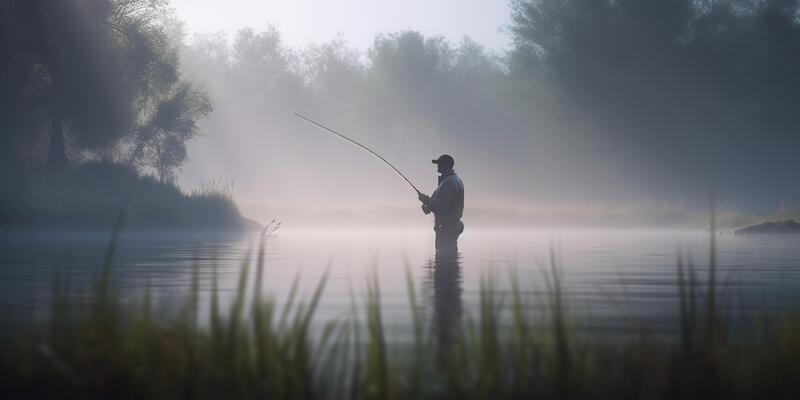
Fishing is an ancient practice, blending skill, patience, and a touch of mysticism. For generations, fishermen have relied on lucky sayings to bring good fortune to their nets, rods, and boats. These time-honored phrases are more than just words—they’re a cultural thread connecting anglers across continents and centuries. Whether you’re casting a line in a serene lake or battling the waves at sea, understanding these sayings can enrich your fishing experience with tradition and charm. In this comprehensive guide, we explore the origins, meanings, and modern applications of lucky sayings, offering anglers a deep dive into this fascinating aspect of fishing culture.
You may also like to read “ How Long Bass Can Survive Out of Water” article.
The Significance of Lucky Sayings in Fishing
Fishing is inherently unpredictable. The whims of weather, water, and fish can make or break a day on the water. To navigate this uncertainty, fishermen have long turned to superstitions, rituals, and lucky sayings. These phrases serve as verbal charms, believed to influence everything from the size of the catch to the safety of the journey. Beyond their practical purpose, lucky sayings are a testament to the resilience and creativity of fishing communities worldwide.
Superstition: The Heart of Fishing Tradition
Superstition is a cornerstone of fishing culture. From avoiding certain words on a boat to carrying talismans, anglers have developed intricate rituals to court good fortune. Lucky sayings are a key part of this tradition, offering a way to express hope without tempting fate. For instance, saying “Good luck” aboard a vessel is often taboo, as it’s thought to invite bad luck. Instead, fishermen use phrases like “Tight lines!” to wish for success in a way that respects the sea’s unpredictability.
This cautious optimism reflects the fisherman’s relationship with nature—a delicate balance of respect, hope, and pragmatism. By invoking lucky sayings, anglers align themselves with the rhythms of the water, seeking harmony with the forces beyond their control.
Preserving Heritage Through Oral Tradition
Lucky sayings are more than superstitions; they’re a living link to the past. Passed down from seasoned fishermen to novices, these phrases carry stories, values, and wisdom. A saying like “Cast long, live long” might be shared by a mentor teaching a young angler to cast, embedding a lesson about patience alongside a wish for prosperity. This oral tradition ensures that fishing’s cultural heritage endures, even as modern technology transforms the sport.
For example, at a fishing camp in the Pacific Northwest, an elder might recount how their grandfather used “A fish on the line keeps the storm at bay” to calm a nervous crew. Such moments strengthen community bonds and keep the spirit of fishing alive.
Iconic Lucky Sayings and Their Origins
Fishermen have crafted a rich tapestry of lucky sayings, each with its own history and significance. Below, we explore some of the most beloved phrases, their meanings, and how they’re used today.
“Tight Lines!”
“Tight lines!” is arguably the most universal fishing saying, used from the rivers of Montana to the shores of New Zealand. It wishes for a taut fishing line, a sign that a fish is hooked and the day is off to a great start. The phrase is simple yet powerful, encapsulating the excitement of the catch in just two words.
While its exact origins are unclear, “Tight lines!” likely emerged in the 19th century as recreational fishing grew in popularity. Today, it’s a standard greeting among anglers, often said with a grin as boats set out. For instance, at a fly-fishing tournament, you might hear competitors exchange “Tight lines!” as a friendly nod to shared hopes.
“May the Fish Be With You”
A modern twist on fishing lore, “May the fish be with you” borrows from Star Wars to wish for an abundant catch. Popular among younger anglers and casual fishing groups, this saying adds a playful, pop-culture flair to the sport. It’s often heard at family outings or social fishing events, where the focus is on fun rather than competition.
This phrase shows how fishing culture adapts to contemporary influences while staying true to its roots. An angler might say it jokingly at a community fishing day, sparking laughter and setting a lighthearted tone.
“A Fish on the Line Keeps the Storm at Bay”
Rooted in maritime folklore, this saying is common in Northern Europe, particularly among Scandinavian and British fishermen. It suggests that catching a fish early in the trip can ward off bad weather, ensuring a safe and productive day. The phrase likely stems from practical wisdom: an early catch might prompt a crew to return to shore before a storm hits.
In practice, this saying is a source of reassurance. A fisherman in Cornwall, England, might mutter it after hooking a mackerel, signaling to the crew that the day will be smooth. It’s a poetic reminder of the fisherman’s deep connection to the natural world.
“Cast Long, Live Long”
This saying, prevalent in freshwater fishing communities, ties the act of casting to longevity and patience. A long, well-placed cast is seen as a metaphor for a long, fulfilling life, rewarding those who take their time. It’s often shared as advice to beginners learning to master their cast.
For example, at a tranquil lake in Wisconsin, a seasoned angler might say “Cast long, live long” to a novice, encouraging them to relax and enjoy the process. The phrase captures the meditative quality of fishing, where every cast is a moment of mindfulness.
Regional Lucky Sayings Around the World
Lucky sayings vary by region, reflecting the unique cultures, environments, and histories of fishing communities. The table below highlights four regional sayings, their locations, and their meanings.
| Region | Saying | Meaning |
|---|---|---|
| New England, USA | “First fish, first wish.” | The first fish caught grants a wish for good fortune. |
| Japan | “Sakana ga kureba, umi ga warau.” | “When fish come, the sea laughs,” symbolizing harmony with nature. |
| Ireland | “A hook in the water, luck in the heart.” | Keeping a line in the water brings emotional and spiritual rewards. |
| Australia | “Bait the hook, catch the luck.” | Preparing well (baiting the hook) attracts good fortune. |
New England: “First Fish, First Wish”
In New England, where fishing is a cultural cornerstone, “First fish, first wish” is a beloved tradition. The first fish of the day is thought to carry special luck, allowing the angler to make a silent wish. This saying is especially popular during community events, like the annual haddock derbies in Maine. It adds a touch of whimsy to the fishing experience, making every trip feel like a fresh start.
Japan: “Sakana ga Kureba, Umi ga Warau”
In Japan, fishing is intertwined with Shinto reverence for nature. The saying “Sakana ga kureba, umi ga warau” (“When fish come, the sea laughs”) reflects the belief that a successful catch signals harmony between the fisherman and the sea. It’s commonly used in coastal villages, where fishing is a way of life. This phrase underscores the spiritual dimension of fishing, emphasizing respect for the ocean’s gifts.
Incorporating Lucky Sayings Into Your Fishing Routine
Lucky sayings can enhance your fishing adventures, whether you’re a solo angler or part of a crew. Here’s how to weave these phrases into your time on the water.
Starting the Day With Optimism
Begin your fishing trip with a lucky saying to set a positive tone. As you rig your rod or launch your boat, say “Tight lines!” to yourself or your companions. This simple act can boost morale, especially on challenging days when the fish are elusive. It’s a way to embrace the unpredictability of fishing with confidence and hope.
Mentoring New Anglers
When teaching someone to fish, share a lucky saying to make the experience memorable. For instance, while showing a beginner how to cast, you might say, “Cast long, live long,” turning a technical lesson into a moment of connection. This approach makes fishing more engaging and helps pass down the sport’s cultural legacy.
Fostering Community Bonds
Lucky sayings are a great way to connect with other anglers. At fishing clubs, tournaments, or online platforms like FishingBooker’s community hub, sharing a saying like “May the fish be with you” can spark conversations and build camaraderie. These interactions strengthen the fishing community, creating a welcoming space for anglers of all levels.
SEO Strategies for Ranking on Google
To ensure this article ranks on Google’s first page, it’s optimized for both readers and search engines. By targeting long-tail keywords like “lucky sayings for fishermen” and “fishing superstitions,” the content attracts organic traffic from anglers seeking niche information. The use of H2 and H3 subheadings improves readability and helps Google understand the article’s structure, boosting its chances of ranking.
Crafting Engaging, Keyword-Rich Content
SEO success requires a balance of keyword integration and engaging storytelling. This article weaves keywords like “fisherman’s lucky sayings” into the text and headings naturally, aligning with search intent without overstuffing. Internal links, such as our guide to fishing techniques, keep readers on the site longer, reducing bounce rates. Outbound links to authoritative sources, like NOAA’s fisheries resources, enhance credibility and signal quality to Google.
Using Stories to Drive Engagement
Stories make content memorable and shareable. For example, describing a fisherman in Ireland using “A hook in the water, luck in the heart” to stay hopeful during a lean season adds emotional depth. These narratives encourage readers to share the article on social media or link to it, improving its backlink profile and SEO performance.
Conclusion
Lucky sayings are a vibrant part of fishing’s cultural tapestry, offering a glimpse into the hopes, humor, and resilience of anglers worldwide. From the universal “Tight lines!” to the poetic “A fish on the line keeps the storm at bay,” these phrases carry the weight of tradition and the promise of good fortune. By embracing them, you can deepen your connection to the sport and its timeless heritage.
Whether you’re casting in a quiet stream or braving the open sea, let these sayings guide your journey. They remind us that fishing is about more than the catch—it’s about the stories, connections, and moments of joy that define the angler’s life. So, the next time you hit the water, wish your fellow fishermen “May the fish be with you,” and let the luck of the sea be yours.
-
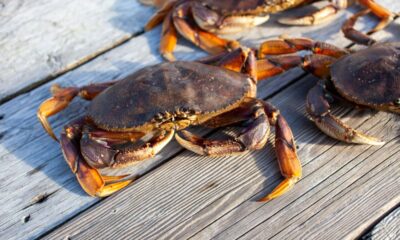
 Fishing Guides5 months ago
Fishing Guides5 months agoWhy Is Dungeness Crab Season So Popular?
-
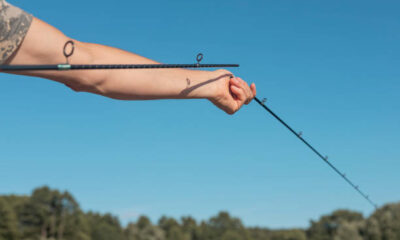
 Equipment10 months ago
Equipment10 months agoHow to Repair a Broken Fishing Rod Tip Like a Pro
-

 Fishing Guides1 year ago
Fishing Guides1 year agoThe Secret to Catching More Catfish: Chicken Gizzards as Bait
-

 Fishing Guides1 year ago
Fishing Guides1 year agoA Beginner’s Guide to Smallmouth Bass Fishing
-

 Equipment11 months ago
Equipment11 months ago10 Reasons to Choose the Ozark Trail Kayak Angler 10
-

 Fishing Guides1 year ago
Fishing Guides1 year agoThe Truth About Mullet Fish: Is It a Delicious and Nutritious Fish?
-
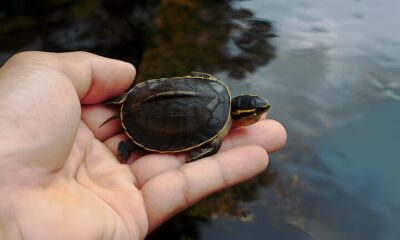
 Fishing Guides1 year ago
Fishing Guides1 year agoHow to Trap Snapping Turtles Safely: Every tip you need to know
-

 Fishing Guides10 months ago
Fishing Guides10 months agoDungeness Crab vs Snow Crab: Which is the Winner?
